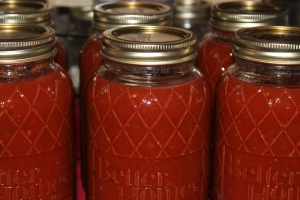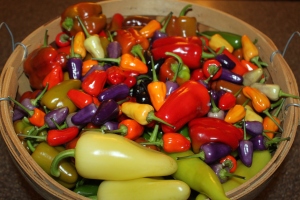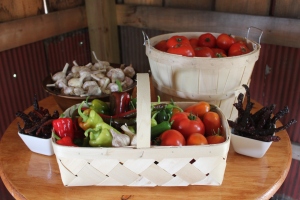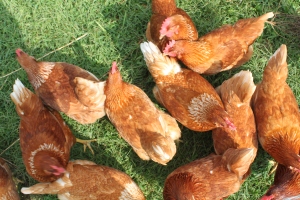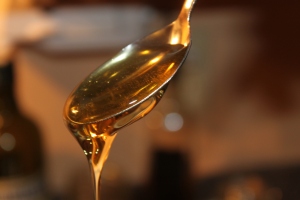More and more people are consuming what they can grow and raise in their own backyards – all in an effort to provide their families with great tasting and safe food. Taking responsibility for one’s own food not only creates healthier options – but helps to eliminate artificial preservatives from diets. In addition – it can also mean consuming food without the harmful chemicals and pesticides that can be prevalent in grocery store produce.
We had that very goal in mind when we started our little plot of land we call the “farm” in the fall of 2010 – to simply become more responsible for the majority of our own food.
Where does one start? Well, what it really boils down to is a little planning to ensure that you meet your food goals.
Our plan materialized when we sat down and created 3 basic phases to attain our goal : 1. Establishing a main garden for fresh food and preserving 2. Creating long-term perennial food sources, and 3. Raising additional non-plant food sources. (In our case, chickens and bees)
Whatever you do, don’t let the size of your land hold you back. Although our farm sits on a little over 3 acres we could easily fit everything we grow on 1/4 acre or less if need be. And even if you own no land at all – don’t let put a stop to your plans. There are plenty of community gardens and open spaces that can be found – or partner up with someone who has the space and share in the bounty. As with any goal – if it means enough to you – there is always a way to be found!
One final tip – when you create your plan – make it specific to you and your family!
If you like lots of garlic, apples and corn – then by all means that is what you should be planting. If you love eggs – then chickens make sense. But just because beets happen to grow particularly well in your soil – it does no good to grow hundreds of them if you and your family won’t eat them. (see: How we stock our home grown grocery store)
So – if you really want to start really growing and raising what you eat – here are the 3 basic building blocks to plan for:
1.Establish A Garden:
Any way you slice it – the garden will always hold the lion’s share of the ability to feed your family the year round.
Start small and keep it manageable. It’s nearly impossible to grow all of your family’s food – and it certainly can’t be done in the first year or two. But when you start a garden, and begin to grow your own tomatoes, cucumbers and peppers – the next thing you know is that beyond fresh salads and vegetables in the summer – you begin to can your own pickles, green beans, salsa, and pasta sauce. Then comes freezing your own sweet corn and soups and stews.
Before you know it – your garden is providing you and your family more of the food you consume each day. (see: 30 recipes to self-sufficiency)
If you have a plot out back – put in a garden. If you have a patio, create some patio planters and grow potted veggies. If you have neither – then find someone who does and rent a small plot, or join a community garden and create your space and get growing. Our garden is truly the centerpiece of our farm and our food life now – and we wouldn’t trade it for the world! (see: Simple Raised Row Gardening)
2. Establish Perennial Food Sources
Although the garden will always be the main source of year round food – it also requires the most effort. One way to provide additional food with less long term effort is through the establishment of perennial food sources. Planting and growing fruit trees, nut trees and bushes along with perennial crops such as asparagus, strawberries, blueberries, blackberries, grapes and more can make a huge dent in your year round food goals.
The key to perennial food sources is that they keep giving back year after year with a fraction of the care your garden needs. Another plus – apples, nuts, grapes and berries of all types have so many additional uses in jams, jellies, pies and a myriad of other dishes.
Without perennial sources of food – it becomes difficult to grow as much as you need without consuming all of your spare time digging and planting. (see: How to plant fruit trees this fall)
3. Establish Additional Non-Plant Food Sources
In addition to what you can grow – what you raise can be a big key to the success of your plan. In our case – it has been our chickens and honey bees. Not only have been able to provide through their eggs and honey – but they have also played a huge role in our garden’s success.
Chickens not only provide a great amount of nutritious and delicious eggs for your household – the additional benefits they provide for your garden and home are amazing!
Chickens help keep insect populations in check – and the fertilizer they provide your compost pile can supply your garden and flowerbeds with all the natural fertilizer you will ever need. (see: Why Raising Chickens and a Garden Go Hand in Hand)
The Bees are the Keys –
And it goes without saying that any good gardener will want the benefits that a hive or two of bees can bring to their crops – not to mention the incredible honey they produce as the by-product.
For us – the two have been a perfect addition to what we grow. Of course, there are many more options as well for those that want to raise other types of livestock – again – the key is to grow and raise what you like.
Happy Homesteading!
Jim and Mary – Old World Garden Farms
If you would like to receive our DIY & Gardening Tips every Tuesday – be sure to sign up to follow the blog via email in the right hand column, “like” us on Facebook, or follow us on Twitter.

